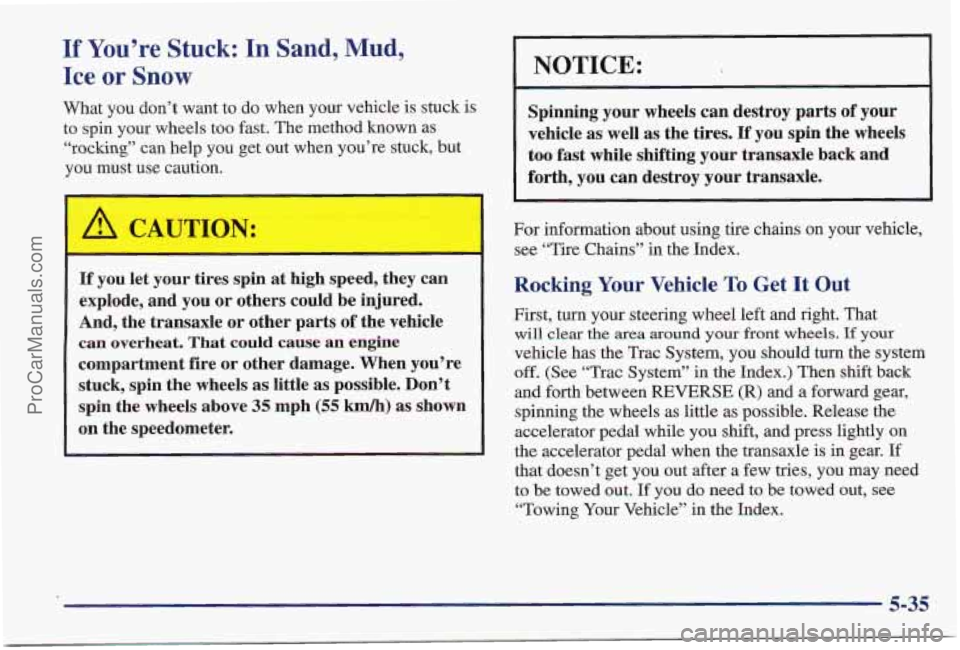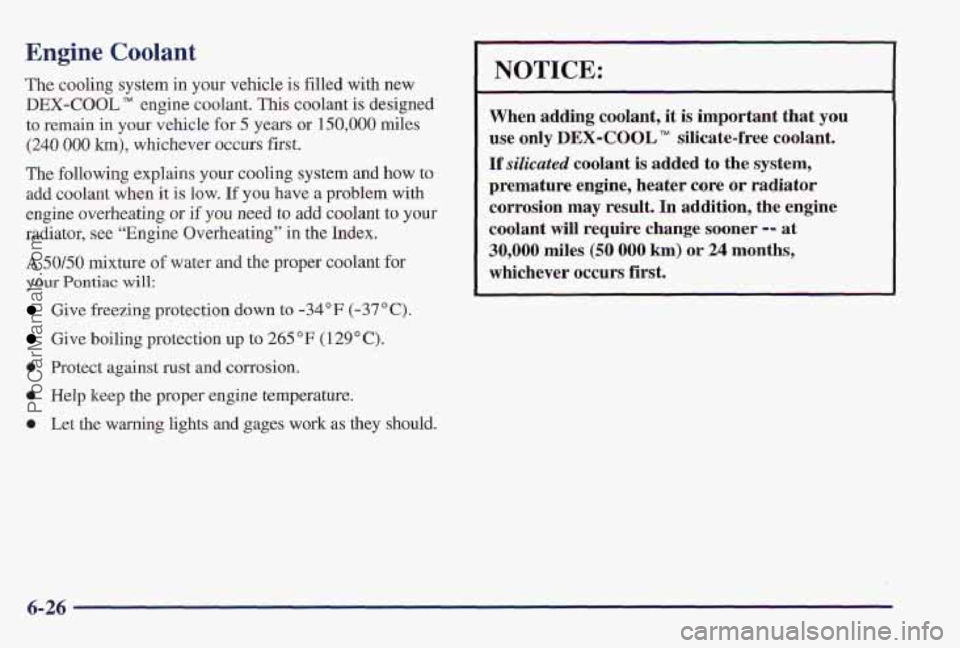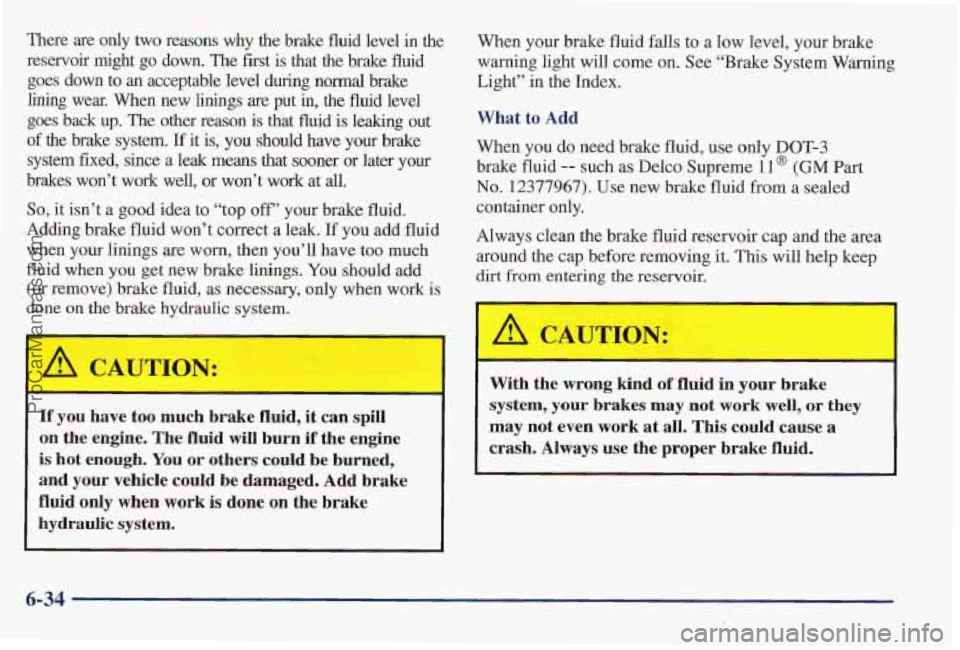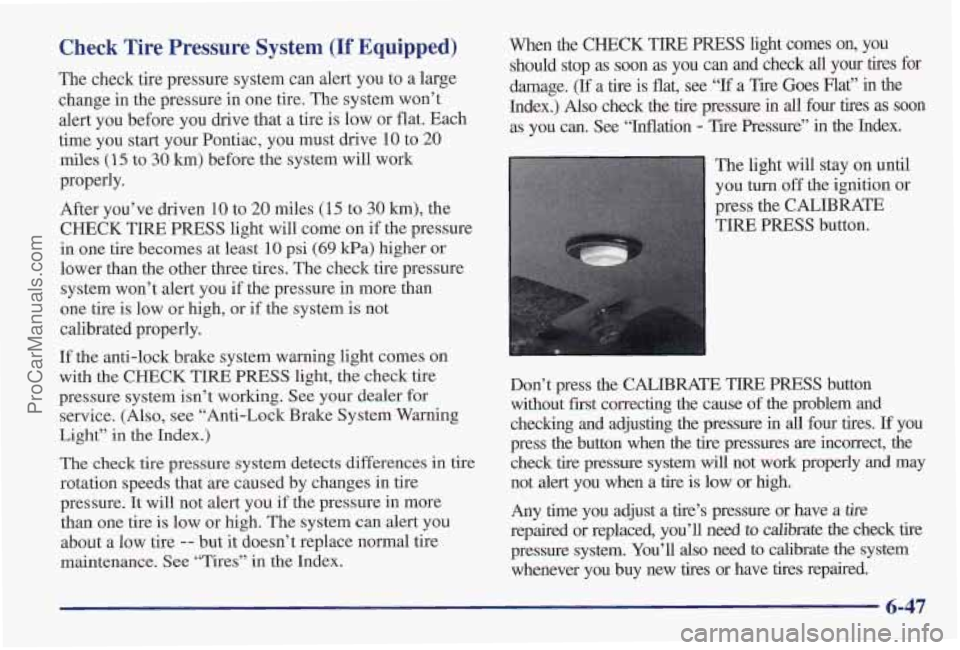1997 PONTIAC PONTIAC light
[x] Cancel search: lightPage 269 of 419

If You’re Stuck: In Sand, Mud,
Ice or
Snow
What you don’t want to do when your vehicle is stuck is
to spin your wheels too fast. The method known as
“rocking” can help you get out when you’re stuck, but
you must use caution.
L
If you let your tires spin at high speed, they can
explode, and you or others could be injured.
And, the transaxle or other parts
of the vehicle
can overheat. That could cause an engine
compartment fire or other damage. When you’re
stuck, spin the wheels
as little as possible. Don’t
spin the wheels above
35 mph (55 km/h) as shown
on the speedometer.
NOTICE:
Spinning your wheels can destroy parts of your
vehicle as well as the tires.
If you spin the wheels
too fast while shifting your transaxle back and
forth, you can destroy your transaxle.
For information about using tire chains on your vehicle,
see “Tire Chains” in the Index.
Rocking Your Vehicle To Get It Out
First, turn your steering wheel left and right. That
will clear the area around your front wheels. If your
vehicle has the Trac System, you should turn the system
off. (See “Trac System” in the Index.) Then shift back
and forth between REVERSE (R) and
a forward gear,
spinning the wheels as little as possible. Release the
accelerator pedal while you shift, and press lightly on
the accelerator pedal when the transaxle
is in gear. If
that doesn’t get you out after a few tries, you may need
to be towed
out. If you do need to be towed out, see
“Towing Your Vehicle” in the Index.
ProCarManuals.com
Page 282 of 419

Before closing the hood, be sure all the filler caps
are on properly. Then just pull the hood down and
close
it firmly.
3800 Supercharged Engine
(If Equipped)
Your Pontiac may have a 3800 Supercharged engine.
The supercharger is a device which is designed to pump
more air into the engine than it would normally
use.
This air mixed with fuel, creates increased engine
power. Since the supercharger is a pump and is driven
from an engine accessory drive belt, increased pressure
is available at all driving conditions.
The powertrain control module (PCM) works with a
vacuum control to regulate the increased pressure
required during specific driving conditions. When this
increased pressure or
boost is not desired, such as during
idling
and light throttle cruising, the excess air that the
supercharger is pumping is routed through
a bypass.
All
of these controls, working together provide high
performance character and fuel efficiency in the
3800 Supercharged engine.
Engine Oil
LOW OIL
LEVEL
If the LOW OIL LEVEL
light on the instrument
panel comes
on, it means
you need to check your
engine oil level right away.
For more information, see
“Low Oil Level Light” in
the Index. You should
check your engine
oil
level regularly; this is an
added reminder.
It’s a good idea to check your engine oil every time you
get fuel, In order to get an accurate reading, the
oil must
be warm and the vehicle must be on level ground.
6-12
ProCarManuals.com
Page 296 of 419

The cooling system in your vehicle is filled with new
DEX-COOL TM engine coolant. This coolant is designed
to remain in your vehicle for 5 years or 150,000 miles
‘(240 000 h), whichever occurs first.
The following explains your cooling system and how to
add coolant when it is low. If you have a problem with
engine overheating or if you need to add coolant to your
radiator, see “Engine Overheating” in the Index.
A $OB0 mixture of water and the proper coolant for
your Pontiac will:
Give freezing protection down to -34°F (-37°C).
Give boiling protection up to 265 “F (129’ C).
0 Protect against rust and corrosion.
0 Help keep the proper engine temperature.
0 Let the warning lights and gages work as they should.
I
NOTICE:
When adding coolant, it is important that you
use only IBEX-COOL TM silicate-free coolant.
If silicated coolant is added to the system,
premature
engine, heater core or radiator
corrosion may result. In addition, the engine
coolant
will requipe change sooner -- at
30,000 miles (50 000 km) or 24 months,
whichever occurs first.
6-26
ProCarManuals.com
Page 298 of 419

Checking Coolant
When your engine is cold, the coolant level should be
at the COLD mark or a little higher. To check coolant
level, remove the cap on the coolant recovery bottle and
verify that
the coolant level is up to the COLD fill level
on the hose attached to the cap.
LOW
COOLANT
If this light comes on, it
means
you’re low on
engine coolant.
Adding Coolant
If you need more coolant, add the proper DEX-COOL”
coolant mixture at the mulant recovery tank.
If the coolant recovery tank is completely empty, add
coolant
to the radiator. (See “Engine Overheating” in
the
Index.)
6-28
ProCarManuals.com
Page 304 of 419

There are only two reasons wny the brake fluid level in the
reservoir might go down. The first is that the brake fluid
goes down to an acceptable level during normal brake
lining wear. When new linings are put in, the fluid level
goes back
up. The other reason is that fluid is leaking out
of the brake system. If it is, you should have your brake
system fixed, since a leak means that sooner or later your
brakes won’t work well, or won’t work at all.
So, it isn’t a good idea to “top off’ y’our brake fluid.
Adding brake fluid won’t correct a leak. If you add fluid
when your linings are worn, then you’ll have
too much
fluid when
you get new brake linings. You should add
(or remove) brake fluid, as necessary, only when work
is
done on the brake hydraulic system.
If you have too much brake fluid, it can spill
on the engine. The fluid will burn
if the engine
is hot enough. You or others could be burned,
and your vehicle could be damaged. Add brake
fluid only when work
is done on the brake
hydraulic system. When your brake
fluid falls
to a low level, your brake
warning light will come on. See “Brake System Warning
Light” in the Index.
What
to Add
When you do need brake fluid,
use only DOT-3
brake fluid -- such as Delco Supreme 11 @ (GM Part
No. 12377967). Use new brake fluid from a sealed
container only.
Always clean the brake fluid reservoir cap and
the area
around the cap before removing
it, This will help keep
dirt from entering the reservoir.
With the wrong kind
of fluid in your brake
system, your
brakes may not work well, or they
may not even work at all. This could cause
a
crash. Always use the proper brake fluid.
6-34
ProCarManuals.com
Page 306 of 419

Some driving conditions or climates may cause a brake
squeal when the brakes are first applied or lightly
applied.
This does not mean something is wrong with
your brakes.
Properly torqued wheel
nuts are necessary to help
prevent brake pulsation, When tires are rotated, inspect
brake pads for wear, and evenly torque wheel nuts in
the proper sequence
to GM specifications.
Brake linings should always be replaced as complete
axle sets.
See “Brake System Inspection” in section
7 of this
manual under
Part C “Perodic Maintenance Inspections,”
Brake Pedal Travel
See your dealer if the brake pedal does not return to
normal height,
or if there is a rapid increase in pedal
travel. This could be a sign of brake trouble.
Brake Adjustment
Every time you apply the brakes, with or without the
vehicle moving, your
brakes adjust for wear.
Replacing Brake System Parts
The braking system on a modern vehicle is complex. Its
many parts have to be of top quality and work well
together if the vehicle is to have really good braking.
Vehicles we design and test have top-quality
GM brake
parts in them,
as your Pontiac does when it is new.
When you replace parts of your braking system
-- for
example, when your brake linings wlear down and you
have to have new ones put in
-- be sure you get new
approved
GM replacement parts. If you don’t, your
brakes may no longer work properly. For example,
if
someone puts in brake linings that are wrong for your
vehicle, the balance between your front and rear brakes
can change -- for the worse. The braking performance
you’ve come to expect can change in many other ways
if
someone puts in the wrong replacement brake parts.
Battery
Every new Pontiac has a Delco Freedom@ battery. You
never have
to add water to ‘one of these. When it’s time
for a new battery, we recommend a Delco Freedom
battery. Get one that has
the replacement number shown
on the original battery’s label.
ProCarManuals.com
Page 317 of 419

Check Tire Pressure System (If Equipped)
The check tire pressure system can alert you to a large
change in the pressure in one tire. The system won’t
alert you before you drive that a tire is low or flat. Each
time you start your Pontiac, you must drive
10 to 20
miles (15 to 30 km) before the system will work
properly.
After you’ve driven
10 to 20 miles (15 to 30 km), the
CHECK TIRE PRESS light will come on if the pressure
in o’ne
tire becomes at least 10 psi (69 kPa) higher or
lower than the other three tires. The check tire pressure
system won’t alert you if the pressure in more than
one tire is low or high, or if the system is not
calibrated properly.
If the anti-lock brake system warning light comes on
with the
CHECK TIRE PRESS light, the check tire
pressure system isn’t working. See your dealer for
service. (Also, see “Anti-Lock Brake System Warning
Light” in
the Index.)
The check tire pressure system detects differences in tire
rotation speeds that are caused by changes in tire
pressure. It will not alert you if the pressure in more
than one tire is low or high. The system can alert you
about
a low tire -- but it doesn’t replace normal tire
maintenance. See “Tires” in
the Index. When
the CHECK
TIRE PRESS light comes on, you
should stop as soon
as you can and check all your tires for
darnage. (If a tire
is flat, see “If a Tire Goes Flat” in the
Index.) Also check the tire pressure in all four tires as soon
as you can. See “Inflation - Tire Pressure” in the Index.
The light will stay on until
you turn off the ignition
or
press the CALIBRATE
TIRE
PRESS button.
Don’t press the CALIBRATE TIRE
PRESS button
without first correcting the cause of the problem and
checking and adjusting the pressure in all four tires.
If you
press the button when the tire pressures
are incorrect, the
check tire pressure system will not work properly
and may
not alert you when a tire is low or high.
Any time you adjust a tire’s pressure or have a
tire
repaired or replaced, you’ll need to calibrate the check tire
pressure system. You’ll
also need to calibrate the system
whenever you buy new tires or have
tires repaired.
6-47
ProCarManuals.com
Page 318 of 419

To calibrate the system:
1. Turn the ignition switch to ON.
2. The CALIBRATE TIRE PRESS button is under the
instrument panel, to the right of the steering column.
Press and hold the button for about three seconds.
The
CHECK TIRE PRFSS light will flash three
times and go out.
If the light doesn’t go out after you
press the
CALIBRATE TIRE PRESS button, see
your dealer for service.
3. The system completes the calibration process during
driving. During the first
10 to 20 miles (15 to 30 km)
of driving, the system will not alert you if a tire is
low or high. After
20 to 80 miles (30 to 125 km), the
system will only alert
you about pressure differences
of
12 psi (85 kPa) or more. After 80 miles (125 km)
of driving, the system will alert you if a tire is 8 psi
(55 Pa) different from the other three tires.
Tire Inspection and Rotation
Tires should be rotated every 6,000 to 8,000 miles
(10 000 to 13 000 km). Any time you notice unusual
wear, rotate your tires as soon as possible and check
wheel alignment. Also check for damaged tires or
wheels. See “When
It’s Time for New Tires” and
“Wheel Replacement” later in this section for
more information. The
purpose
of regular rotation is to achieve more
uniform wear for all tires on the vehicle. The first
rotation is the most important. See “Scheduled
Maintenance Services” in the Index for scheduled
rotation intervals.
When rotating your tires, always use
the correct rotation
pattern shown here.
Don’t include the compact spare tire in your tire rotation.
6-48
ProCarManuals.com